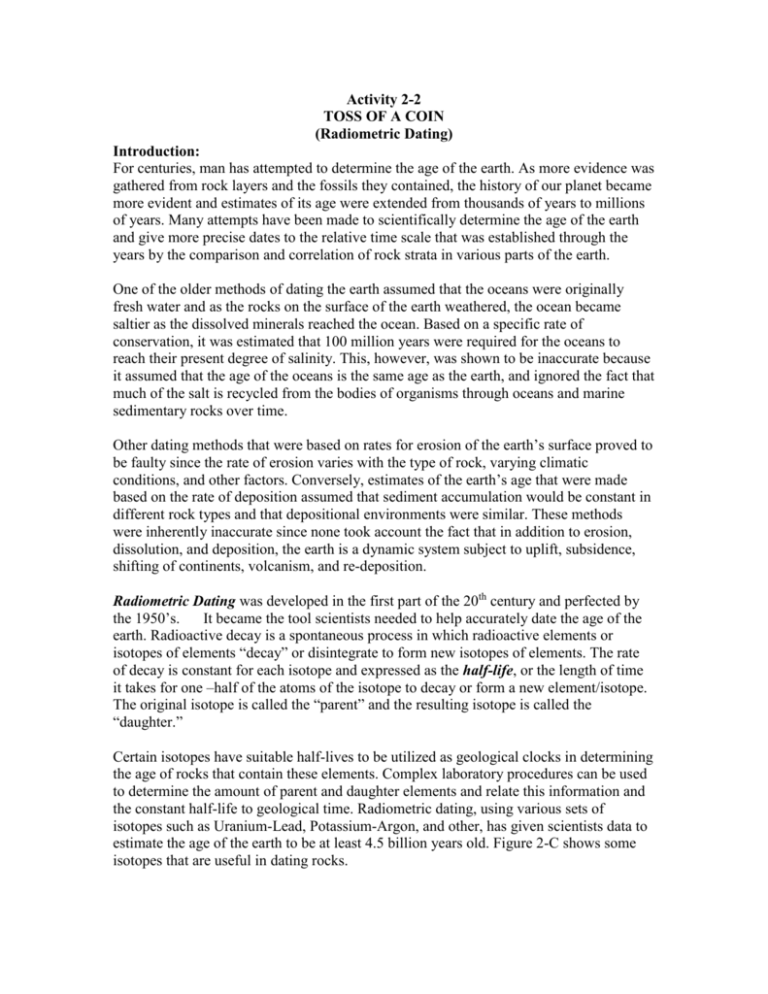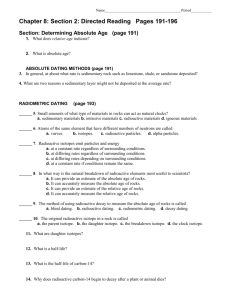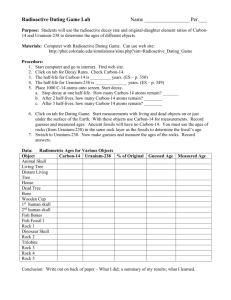toss of a coin2013
advertisement

Activity 2-2 TOSS OF A COIN (Radiometric Dating) Introduction: For centuries, man has attempted to determine the age of the earth. As more evidence was gathered from rock layers and the fossils they contained, the history of our planet became more evident and estimates of its age were extended from thousands of years to millions of years. Many attempts have been made to scientifically determine the age of the earth and give more precise dates to the relative time scale that was established through the years by the comparison and correlation of rock strata in various parts of the earth. One of the older methods of dating the earth assumed that the oceans were originally fresh water and as the rocks on the surface of the earth weathered, the ocean became saltier as the dissolved minerals reached the ocean. Based on a specific rate of conservation, it was estimated that 100 million years were required for the oceans to reach their present degree of salinity. This, however, was shown to be inaccurate because it assumed that the age of the oceans is the same age as the earth, and ignored the fact that much of the salt is recycled from the bodies of organisms through oceans and marine sedimentary rocks over time. Other dating methods that were based on rates for erosion of the earth’s surface proved to be faulty since the rate of erosion varies with the type of rock, varying climatic conditions, and other factors. Conversely, estimates of the earth’s age that were made based on the rate of deposition assumed that sediment accumulation would be constant in different rock types and that depositional environments were similar. These methods were inherently inaccurate since none took account the fact that in addition to erosion, dissolution, and deposition, the earth is a dynamic system subject to uplift, subsidence, shifting of continents, volcanism, and re-deposition. Radiometric Dating was developed in the first part of the 20th century and perfected by the 1950’s. It became the tool scientists needed to help accurately date the age of the earth. Radioactive decay is a spontaneous process in which radioactive elements or isotopes of elements “decay” or disintegrate to form new isotopes of elements. The rate of decay is constant for each isotope and expressed as the half-life, or the length of time it takes for one –half of the atoms of the isotope to decay or form a new element/isotope. The original isotope is called the “parent” and the resulting isotope is called the “daughter.” Certain isotopes have suitable half-lives to be utilized as geological clocks in determining the age of rocks that contain these elements. Complex laboratory procedures can be used to determine the amount of parent and daughter elements and relate this information and the constant half-life to geological time. Radiometric dating, using various sets of isotopes such as Uranium-Lead, Potassium-Argon, and other, has given scientists data to estimate the age of the earth to be at least 4.5 billion years old. Figure 2-C shows some isotopes that are useful in dating rocks. (Figure 2-C) ISOTOPES COMMONLY USED TO DATE ROCKS Parent Half-Life Daughter Materials Commonly Dated With Method Rubidium-87 47,000 million years Strontium-87 muscovite, lepidolite, biotite, metamorphic rocks Uranium-238 4,470 million years Lead-206 zircon,uraninite, pitchblende Potassium-40 1,300 million years Argon-40 muscovite, hornblende, biotite, glauconite, whole volcanic rocks Uranium-235 713 million years Lead-207 zircon, uraninite, pitchblende Carbon-14 Nitrogen-14 organic remains, coal 5,730 years In addition to dating rock, scientists can use Carbon-14 to date organic materials such as wood, charcoal, or bone (not mineralized). All living things contain the element carbon and have a constant proportion of radioactive Carbon-14 to more common nonradioactive Carbon-12 isotope. When an organism dies, Carbon-14 is no longer being replenished (i.e., Carbon-14 is no longer in equilibrium with Carbon-12 and the ratio is not constants). As Carbon-14 converts or “decays” into Nitrogen-14, the ration of the remaining Carbon-14 and Carbon-12 can be used to estimate the age of organic remains. In addition to being limited to organic remains, Carbon-14 dating is applicable only in dating events accurately within the past 100,000 years. Since the half-life of Carbon-14 is only 5,730 years, nearly all the Carbon-14 would have been converted to Nitrogen-14 in organic remains older than 100,000 years. In this activity, you will simulate radiometric dating of Carbon-14 by using common pennies. Objectives: When you finish this activity, you will be able to: 1. Explain what half-life means; 2. Demonstrate how the half-life of an element can be represented by a group of pennies; 3. Give the approximate age of the earth; and 4. Distinguish between relative and radiometric dating. Materials: shoe box (or plastic volcano box from the Earth Science Curriculum Project), 100 pennies, paper, graph paper (Figure 2-D), and pencil. Procedure: 1. 2. 3. 4. 5. Set up a data table on a sheet of notebook paper that resembles the sample given below. You will be recording the “Total Number of Pennies in the Box” and the “Shake.” Pick up the required materials to complete the experiment. Place all 100 pennies in the bottom of the box, “tail” side up. On your data sheet, record that there are 100 pennies on shake zero. Carefully shake the box so that no pennies fall out. Remove the pennies with the “head: side up. Count the pennies you removed and subtract from the previous total to find out the number of pennies left in the box. Continue shaking the box and removing the pennies with the “heads” up until no pennies remain in the box. Number of shakes (Half lives) number of heads left (parent isotopes) 0 100 1 2 3 4 5 6 7 Graph 1. Make a graph of the data from the experiment. The number of shakes represents the time it takes for one half life to occur. For this graph the half life is 1,000 years. This is the independent variable and should be placed on the x-axis. 2. Most of you will have between 7 and 8 half lives so you need to space out our graph they can all fit on the graph. For example, if it took you 7 shakes to remove all of the heads than you had 7 half lives. This mean your x-axis should go from 0 to 7000 yrs with 1,000 year intervals. 3. The y-axis is the % of parent isotope left in the rock. In our example that was represented by the number of pennies that were heads. Your y-axis should start at 0 and go to 100. You will need to decide the intervals but make your graph take up as much space as possible. Prep, H, and HH Questions: 1. In this experiment, what do pennies with “tails” showing represent? 2. In this experiment, what pennies with “heads” showing represent? 3. Define half-life. 4. If your data on the graph represented the element Carbon-14, shake three would represent an organism that was how old? 5. If your data on the graph represented an element with the half-life of 1,000 years, how old would an organism be if 80% of the parent isotope were left? 6. Would Carbon-14 dating be more useful in dating the age of a dinosaur that lived 200 million years ago or a woolly mammoth that live 25,000 years ago? Explain. 7. Would Carbon-14 dating be useful to date the age of the earth? Explain. 8. Explain how radiometric dating is different that relative dating (Activity 2-1). Which method is more accurate? H and HH Questions: Answer the following questions using the graph you created. 1. If the data on your graph represented an element with a half-life of 1,000 years, how old would an organism be if 10% of the parent isotope were left? 2. If the data on your graph represented an element with a half-life of 1,000 years, how old would an organism be if 70% of the daughter isotope were left? 3. If an organism is 4,500 years old, what percent of the radioactive isotopes would be the parent isotope? Use a half-life of 1,000 years. 9. The half-life of Uranium-238 is 4.47 billion years. Assuming that no new Uranium-238 is being generated on earth, approximately how much of the original amount of Uranium-238 is left on earth? HH Question: There are many errors involved in radiometric dating. One assumption is that when a rock was formed, there were no daughter elements present in the minerals being analyzed (only parent elements). How would you design an experiment to include daughter elements that are present at the formation of a rock? How will the addition of daughter elements that are present at the formation of a rock change the outcome of the experiment.









